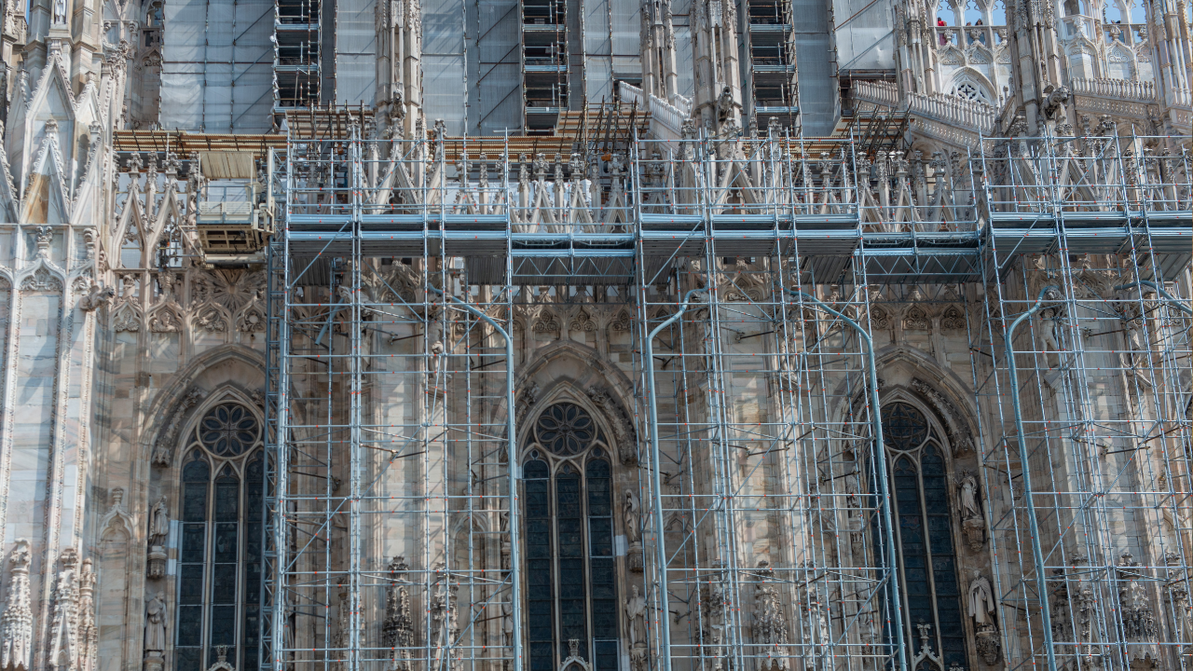The Sky-High History of Scaffolding: From Ancient Egypt to Modern Skyscrapers
Welcome, history buffs and construction enthusiasts alike, to a journey through time—a journey that will take us up high, down low, and across the centuries, all while exploring the fascinating history of scaffolding!
Ancient Roots: Building the Pyramids
Our story begins in ancient Egypt, around 4,500 years ago. The Great Pyramid of Giza, one of the Seven Wonders of the Ancient World, didn't just rise from the desert sands by itself. The Egyptians used rudimentary scaffolding, likely made from wood, to reach those dizzying heights. Where did they get the wood? Most Likely from areas such as Lebanon which at one time had massive cedar trees. This would have been an expensive endeavor, but the great kings spared no expense! Imagine laborers clambering up these primitive structures, hauling massive limestone blocks to create a tomb fit for a pharaoh. Talk about an engineering marvel!
Classical Construction: Greece and Rome
Fast forward to ancient Greece and Rome, where scaffolding took a more refined form. The Parthenon in Athens and the Colosseum in Rome were monumental undertakings. The Greeks and Romans employed wooden scaffolding and a mix of ladders and ropes, demonstrating their advanced understanding of construction techniques. The Aqueducts were built using cantilever and trestle style scaffolding. These ancient architects knew that sturdy scaffolding was essential for safety and efficiency.
Medieval Masterpieces: Cathedrals and Castles
In the medieval period, scaffolding was crucial in constructing cathedrals, castles, and other grand structures. Gothic cathedrals, with their soaring spires and intricate stonework, required extensive scaffolding. Builders used timber frameworks that enveloped the growing structures like skeletal exoskeletons. The scaffolding was so integral that it often became a part of the construction process, evolving as the building rose higher.
The Renaissance: Innovation and Ingenuity
The Renaissance era brought a renewed focus on art, science, and architecture. Scaffolding during this period saw significant advancements. Leonardo da Vinci, ever the visionary, sketched designs for more efficient scaffolding systems. The use of pulleys, hoists, and improved materials made scaffoldings sturdier and more versatile, allowing for the creation of elaborate frescoes and majestic domes.
The Industrial Revolution: Steel Takes the Stage
The 19th-century Industrial Revolution was a game-changer for scaffolding. The introduction of steel provided a stronger and more durable alternative to wood. Steel scaffolding could support heavier loads and reach greater heights, which was perfect for the era's ambitious architectural projects. The Eiffel Tower, completed in 1889, is a prime example of how steel scaffolding revolutionized construction.
Modern Marvels: From Skyscrapers to Space
In the 20th and 21st centuries, scaffolding has evolved in leaps and bounds. Modular scaffolding systems, made from lightweight and robust materials, can be quickly assembled and disassembled, adapting to the ever-changing needs of construction sites. Modern scaffolding is not just for buildings; it's used for everything from maintaining massive oil rigs to constructing spacecraft. The Burj Khalifa in Dubai, the tallest building in the world, relied on cutting-edge scaffolding techniques to soar above the clouds.
Safety First: The Evolution of Standards
Throughout its history, scaffolding has evolved not only in terms of materials and design but also in safety standards. Today, stringent regulations ensure that scaffolding is erected and used safely, protecting the lives of workers and passersby. Innovations such as guardrails, harnesses, and netting have made construction sites safer than ever before.
Scaffolding in Pop Culture
Scaffolding has even made its way into pop culture. From action-packed movie scenes where heroes dangle precariously from scaffoldings to iconic photographs of workers having lunch atop skyscrapers, these structures symbolize both human ambition and the ever-present need for a solid foundation in our endeavors.
The Future of Scaffolding
As we look to the future, scaffolding will continue to evolve with advancements in technology and materials. Who knows? Maybe we'll see scaffolding made from innovative materials or even self-assembling structures. One thing is for sure: wherever there's a need to build something grand, scaffolding will support our dreams and ambitions every step of the way. So, next time you walk past a construction site, take a moment to appreciate the scaffolding. It's more than just a temporary structure; it's a testament to centuries of innovation and human ingenuity. And who knows? It'll inspire you to reach new heights in your own endeavors.
Recent Posts
-
How Scaffolding Impacts Project Scheduling and Deadlines
When people think about project delays, they usually blame weather, material shortages, or labor iss …Dec 15th 2025 -
Working With Scaffolding in Winter
Winter may slow construction down, but it doesn’t stop it, and when scaffolding is involved, cold-se …Dec 8th 2025 -
When Renovation Turns Risky: Lessons from the Tai Po Fire and the Role of Scaffolding Safety
The recent fire in Hong Kong’s Tai Po district has shaken the global construction and safety communi …Nov 30th 2025




